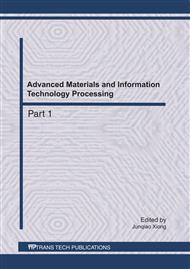[1]
J.R. Wolpaw, N. Birbaumer, D.J. McFarland, G. Pfurtscheller and T.M. Vaughan, Brain-computer interfaces for communication and control, Clinical Neurophysiology, vol. 113, no. 6, pp.767-791, (2002).
DOI: 10.1016/s1388-2457(02)00057-3
Google Scholar
[2]
E.C. Lalor, S.P. Kelly, C. Finucane, R. Burke, R. Smith, R.B. Reilly and G. McDarby, Steady-state vep-based brain-computer interface control in an immersive 3d gaming environment, EURASIP Journal on Applied Signal Processing, vol. 2005, no. 19, pp.3156-3164, (2005).
DOI: 10.1155/asp.2005.3156
Google Scholar
[3]
J. d.R. Millán, F. Renkens, J. Mouriño and W. Gerstner, Noninvasive brain-actuated control of a mobile robot by human eeg, IEEE Transactions on Biomedical Engineering, vol. 51, pp.1026-1033, (2004).
DOI: 10.1109/tbme.2004.827086
Google Scholar
[4]
J.R. Wolpaw, Brain-computer interfaces as new brain output pathways, The Journal of Physiology, vol. 579, no. 3, pp.613-619, (2007).
DOI: 10.1113/jphysiol.2006.125948
Google Scholar
[5]
T. Lüth, D. Ojdanić, O. Friman, O. Prenzel and A. Gräser, Low level control in a semi-autonomous rehabilitation robotic system via a brain-computer interface", Proceedings of the 10th International Conference on Rehabilitation Robotics (ICORR, 07), Noordwijk, Jun. 2007, pp.721-728.
DOI: 10.1109/icorr.2007.4428505
Google Scholar
[6]
D. Valbuena, M. Cyriacks, O. Friman, I. Volosyak and A. Gräser, Brain-computer interface for high-level control of rehabilitation robotic systems", Proceedings of the 10th International Conference on Rehabilitation Robotics (ICORR, 07), Noordwijk, Jun. 2007, pp.619-625.
DOI: 10.1109/icorr.2007.4428489
Google Scholar
[7]
B. Graimann, B. Allison, C. Mandel, T. Lüth, D. Valbuena and A. Gräser, Robust Intelligent Systems, Springer Verlag, 2008, ch. 6, pp.113-138.
DOI: 10.1007/978-1-84800-261-6_6
Google Scholar
[8]
C. Guger, C. Holzner, C. Grönegress, G. Edlinger and M. Slater, Brain-computer interface for virtual reality control", ESANN, 2009 proceedings, European Symposium on Artificial Neural Networks - Advances in Computational Intelligence and Learning, Bruges, Apr. 2009, pp.443-448.
DOI: 10.1109/ner.2009.5109333
Google Scholar
[9]
L.A. Farwell and E. Donchin, Talking off the top of your head: toward a mental prosthesis utilizing event-related brain potentials, Electroencephalography and clinical neurophysiology, vol. 70, no. 6, pp.510-523, (1988).
DOI: 10.1016/0013-4694(88)90149-6
Google Scholar
[10]
C. Arrouët, M. Congedo, J. -E. Marvie, F. Lamarche, A. Lécuyer and B. Arnaldi, Open-vibe: A three dimensional platform for real-time neuroscience, Journal of Neurotherapy: Investigations in Neuromodulation, Neurofeedback and Applied Neuroscience, vol. 9, no. 1, pp.3-25, (2005).
DOI: 10.1300/j184v09n01_02
Google Scholar
[11]
B. Rivet, A. Souloumiac, V. Attina and G. Gibert, xdawn algorithm to enhance evoked potentials: Application to brain computer interface, IEEE Transactions on Biomedical Engineering, vol. 56, no. 8, pp.2035-2043, (2009).
DOI: 10.1109/tbme.2009.2012869
Google Scholar
[12]
G. Bradski and A. Kaehler, Learning OpenCV, O'Reilly Media, (2008).
Google Scholar
[13]
J.A. Corrales Ramón, P. Gil Vázquez, F.A. Candelas Herías and F. Torres Medina, Tracking based on hue-saturation features with a miniaturized active vision system", Proceedings of the 40th International Symposium on Robotics (ISR, 09), Barcelona, Mar. 2009, pp.107-112.
Google Scholar


